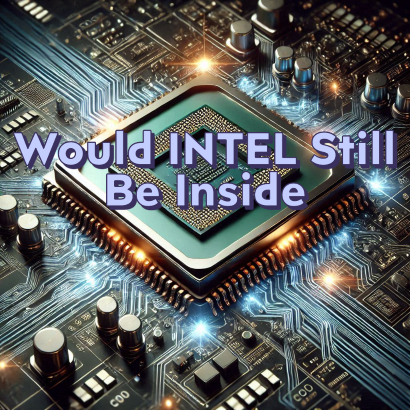Shocking Facts About Intel “From Dominance to Decline”

A summary of Intel’s recent market share and revenue data (2024 December)
Market Share:
Intel has faced significant erosion in its market share over the years, primarily due to competition from AMD and ARM-based processors. In the PC processor market, Intel’s share was around 66% as of Q1 2024, a decline from its historically dominant position above 80% in the 2010s. In data center processors, AMD’s EPYC line has steadily gained ground, with AMD securing approximately 30% of the market as of 2024, compared to nearly negligible levels a decade ago.
Revenue Overview:
Intel’s financial performance has been fluctuating:
- Q3 2024 Revenue: $13.28 billion, a decline of 6.17% year-over-year. Total revenue for the last twelve months was $54.25 billion, a slight increase of 2.62% from the previous year.
- Annual Trends:
- 2023: $54.23 billion (-14.00% from 2022).
- 2022: $63.05 billion (-20.21% from 2021).
- 2021: $79.02 billion (+1.49% from 2020).
- 2020: $77.87 billion (+8.20% from 2019).
Online Paid Consultations
TRAINING | BUSINESS MENTORING | LIFE COACHING | PROJECT MENTORING | CONSULTATION
LIVE ONLINE IN PERSON COACHING
Chat / Call / Video Call
HOW DOES OUR ONLINE PAID CONSULTATION WORKS
YOU CAN CHOOSE CHAT / CALL / VIDEO CALL OPTIONS
1. CLICK ON THE LINK “CHECK YOUR BOOKING OPTIONS AND PRICING“.
2. YOU WILL BE REDIRECTD TO SECURE PAYPAL PAGE
3. CHOOSE AN OPTION FROM THE DROP DOWN MENU
4. CHOOSE NUMER OF SESSIONS (1 is selected by default)
5. MAKE SECURE PAYMENT VIA PAYPAL
6. DONE! WE WILL SEND IN YOUR MEETING DETAILS ON YOUR MAIL ID. YOU CAN CHOOSE A SLOT AND MEDIUM OF YOUR CHOICE.
The Genesis of Intel
Intel Corporation, founded in 1968 by Gordon Moore and Robert Noyce in Santa Clara, California, played a transformative role in shaping the modern tech industry. Initially focusing on memory chips, Intel quickly revolutionized computing by introducing the first commercially available microprocessor, the Intel 4004, in 1971. This innovation marked the beginning of Intel’s dominance in the semiconductor industry.
The Golden Era of Intel
Throughout the 1980s and 1990s, Intel became synonymous with innovation and growth. The company’s x86 microprocessor architecture became the gold standard for personal computing, powering machines from companies like IBM and later Microsoft’s Windows platform. Intel’s “Intel Inside” marketing campaign in the 1990s cemented its brand identity, making it a household name.
The Pentium processor series, launched in 1993, was a monumental success, driving performance improvements that fueled the PC revolution. Intel’s ability to scale manufacturing and innovate at a rapid pace made it the undisputed leader in the chipmaking industry for decades.
Diversification and Challenges
In the early 2000s, Intel attempted to diversify its portfolio by entering markets such as mobile processors and embedded systems. However, competition from companies like ARM in the mobile space presented challenges. While Intel dominated the server and PC markets, it struggled to gain a foothold in mobile and low-power devices.
Despite these challenges, Intel maintained its leadership in semiconductor manufacturing, leveraging Moore’s Law—the observation that the number of transistors on a chip doubles approximately every two years—to continually push technological boundaries.
The Rise of Competitors
The 2010s marked a turning point for Intel. Competitors like AMD, NVIDIA, and ARM began to make significant inroads into markets traditionally dominated by Intel.
AMD: With the release of its Ryzen processors in 2017, AMD delivered products that matched or surpassed Intel’s performance at competitive prices, eroding Intel’s market share in both consumer and server markets.
NVIDIA: NVIDIA’s focus on GPUs (graphics processing units) positioned it as a leader in AI, machine learning, and gaming markets. These areas became increasingly important as demand for AI-driven applications grew.
ARM: ARM’s energy-efficient architecture became the standard for mobile devices. In recent years, ARM-based processors have also gained traction in data centers and high-performance computing, thanks to innovations by companies like Apple and Amazon.
Why is Intel Losing Market Share?
Delayed Innovation: Intel’s inability to transition to smaller manufacturing nodes on schedule—such as the shift to 10nm and later 7nm—allowed competitors to gain a technological edge. TSMC and Samsung now lead in advanced chip manufacturing.
Competition from AMD: AMD’s adoption of chiplet architecture and advanced manufacturing processes through partnerships with TSMC has resulted in processors that outperform Intel’s in key metrics such as power efficiency and multi-threaded performance.
Shift in Computing Trends: The rise of cloud computing, AI, and edge computing has shifted demand toward specialized processors, areas where Intel has lagged behind competitors like NVIDIA and ARM.
Strategic Missteps: Intel’s failure to capitalize on the mobile processor market and its delay in embracing AI-driven technologies have put it at a disadvantage. Companies like Apple—which transitioned to its own ARM-based processors—have reduced dependency on Intel.
Geopolitical and Supply Chain Issues: The global semiconductor shortage, coupled with geopolitical tensions, has strained Intel’s supply chain and impacted its ability to meet demand.
Intel’s Future Prospects
Despite its challenges, Intel is far from out of the game. The company has embarked on a turnaround strategy under CEO Pat Gelsinger, focusing on the following areas:
Revamping Manufacturing: Intel plans to regain its leadership in chip manufacturing through its IDM 2.0 strategy, which includes building new fabs and leveraging advanced process technologies.
Expanding Foundry Services: Intel aims to compete with TSMC and Samsung by offering foundry services, manufacturing chips for other companies.
Investing in AI and GPUs: Intel is developing its own line of GPUs and AI accelerators to compete with NVIDIA and AMD in these high-growth markets.
Strategic Acquisitions: Intel has made strategic acquisitions, such as Mobileye (autonomous driving technology), to diversify its offerings and tap into emerging markets.
Conclusion
Intel’s journey from a pioneering force in microprocessors to a company facing stiff competition underscores the dynamic nature of the tech industry. While it has lost market share in recent years, Intel’s efforts to innovate and adapt suggest that it could yet reclaim its position as a leader in the semiconductor world. The next few years will be crucial in determining whether Intel can successfully navigate this challenging landscape.

Syed Saif the founder and CEO of Brainow Consulting. He has over 24 Years of experience in Quality, Excellence, Innovation, Six Sigma, Lean, and Customer Services. He is a Certified Master Black Belt, ISO Lead Auditor, High Impact Trainer, Certified Business Excellence Assessor, Certified on Innovation Business Model Canvas, and holds a PG diploma in Customer Relationship Management. Syed Saif has trained thousands of people, from students to CEOs on various improvement methodologies and self help techniques, and has worked in various industries including BPO, Telecom, IT, Insurance, Manufacturing, and Healthcare. Prior to his full-time consulting role, he served as Vice President for a Leading Insurance Company and as National Head of Quality, Innovation, and Service for Corporate and Sales Functions. See our services page for more details on what we do and how can we help you and your organization.
